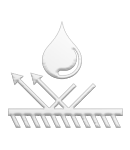Grades of Neodymium Magnets
Learn about all available magnet grades and properties below.
Neodymium Magnet Grades
If you’re looking at buying neodymium (NdFeB) magnets, you’ll have noticed terms such as N35, N42 or N52. But what do these actually mean?
There are different grades of magnets which are used for different purposes. The grade of a magnet refers to its magnetic strength, or how strong the magnetic field is. The higher the number next to the ‘N’, the stronger the magnet. For example, N42 has a stronger magnetic field than N35.
In less common instances, you may see letters after the grade, for example, N45SH. The SH are neodymium magnets that have been specially manufactured to withstand demagnetisation forces like extreme heat or magnetic pulses. This is often referred to as the magnet’s coercivity and you can read more about this here.

What Are Popular Neodymium Grades?
Neodymium grades can start as low as N25 and go as high as N55. The available standard neodymium grades are N35, N38, N40, N42, N45, N48, N50, N52 and N55. The grades can also be read as 35 MGOe, 38 MGOe, 42 MGOe and so on. Higher grades typically cost slightly more per unit than lower grades, but what is the most common grade?
Grade N35
This grade of magnet is less powerful than the others but ideal for many consumer applications. These are still powerful magnets, but they’re more cost effective than higher grades.
Grade N42
This grade of magnet is very powerful and is commonly used in industrial applications. This includes machinery, electric motors and other applications that require a powerful magnetic field. We find N42 is the most common grade used due to the balance between cost and performance.
Grade N52
This is one of the highest grade of magnet available. It has one of the strongest magnetic fields and is used in applications where high performance is required, such as in electric motors and generators.
What Is The Strongest Grade?
The strongest grade of neodymium is N55. Many sources on the internet state that N52 is the strongest grade but that is old data and no longer the case. With modern equipment, it’s now possible to produce N55 grade magnets which have a Br (KG) of 14.4-14.6. The disadvantage of N55 magnets is they cost more than any other grade so they’re only used where power is more important than price.
Technical Definitions
Remanence (Br) – This is the measurement for the material’s ability to retain magnetism after being exposed to a powerful magnetic pulse. The higher this unit, the more magnetism the material can retain and consequently, the stronger the magnet.
Coercive Force (Hc) The measurement to eliminate the magnetic field when exposed to an opposing magnetic field. The higher this unit, the more resistance a magnet has to demagnetisation.
Intrinsic Coercive Force (Hci) The required strength of the opposing magnetic field to completely demagnetise a magnet to the value of 0.
Maximum Energy Product (BH)max – This measurement shows the magnetic density of a material that produces a magnetic field. This measurement establishes how powerful a magnetic field is and it’s often abbreviated as MGOe.
kG (KiloGauss) – 1 Kilogauss = 1000 Gauss. Gauss is the unit of measurement that measures magnetic induction.
T (Tesla) – 1 Tesla = 10,000 Gauss. Tesla is the unit of measurement that measures magnetic induction.
Oe – Oersted – A measurement of magnetic field strength.
kA/m (kiloampere) – 1 kiloampere = 12.56 oersted – A measurement of magnetic field strength
MGOe (Maximum Energy Product) – The unit of measurement that refers to the strength, power or magnetic density of a magnetic field.
kJ/m³ (Kilojoule per Cubic Meter) – 1 Kilojoules = 1,000 Joules – The unit of measurement for energy.

Technical Definitions
Remanence (Br) – This is the measurement for the material’s ability to retain magnetism after being exposed to a powerful magnetic pulse. The higher this unit, the more magnetism the material can retain and consequently, the stronger the magnet.
Coercive Force (Hc) The measurement to eliminate the magnetic field when exposed to an opposing magnetic field. The higher this unit, the more resistance a magnet has to demagnetisation.
Intrinsic Coercive Force (Hci) The required strength of the opposing magnetic field to completely demagnetise a magnet to the value of 0.
Maximum Energy Product (BH)max – This measurement shows the magnetic density of a material that produces a magnetic field. This measurement establishes how powerful a magnetic field is and it’s often abbreviated as MGOe.
kG (KiloGauss) – 1 Kilogauss = 1000 Gauss. Gauss is the unit of measurement that measures magnetic induction.
T (Tesla) – 1 Tesla = 10,000 Gauss. Tesla is the unit of measurement that measures magnetic induction.
Oe – Oersted – A measurement of magnetic field strength.
kA/m (kiloampere) – 1 kiloampere = 12.56 oersted – A measurement of magnetic field strength
MGOe (Maximum Energy Product) – The unit of measurement that refers to the strength, power or magnetic density of a magnetic field.
kJ/m³ (Kilojoule per Cubic Meter) – 1 Kilojoules = 1,000 Joules – The unit of measurement for energy.







